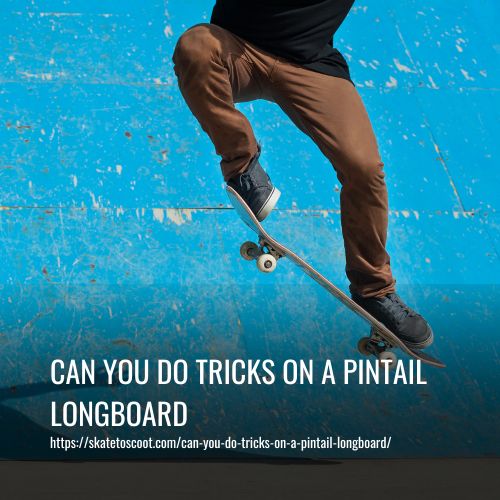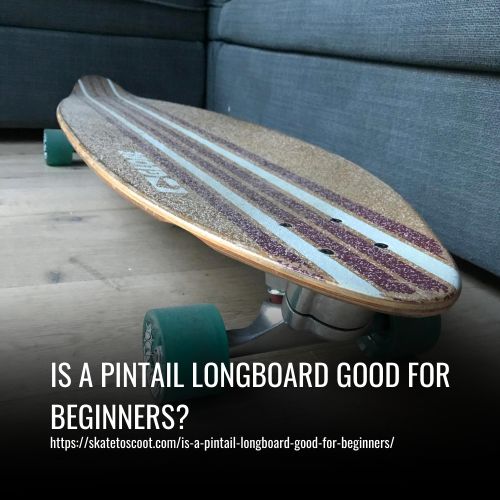As an Amazon Associate we earn from qualifying purchases.
Yes, you can definitely do tricks on a pintail longboard. While pintail boards are typically known for their cruising capabilities and smooth ride on flat surfaces, they can also be used for executing basic tricks and maneuvers.
For beginner longboard riders, pintail boards are a popular choice as they offer stability and control. The longboard deck, with its gentle concave shape, provides a comfortable foot placement for riders of all skill levels.

How to Do Tricks on a Pintail Longboard
If you’re looking to take your longboarding skills up a notch, the Pintail is the perfect board for you. With its stability and control, it’s the ideal choice for learning tricks. Here are some tips that will help you master tricks on a pintail longboard:
1. Goofy or Regular Rider?
When it comes to riding a pintail longboard, one important consideration is whether you are a goofy or regular rider. This refers to your foot placement while riding. Goofy riders have their right foot forward, while regular riders have their left foot forward.
Determining whether you are goofy or regular is crucial because it affects your stability and maneuverability on the board. It is essential to have the correct foot placement to ensure a smooth ride and perform tricks effectively.
To determine your riding style, try standing on a flat surface and ask a friend to give you a gentle push from behind. The foot that you instinctively use to balance yourself and stabilize on the board will indicate which stance you prefer.
2. Ride on a Flat Surface
Before attempting any tricks on a pintail longboard, it is essential to first develop your basic riding skills on a flat surface. Riding on a flat surface allows you to find your balance and become comfortable with the board’s movements.
Begin by standing on the longboard on level ground. Practice shifting your weight from one foot to another to get a feel for the board’s responsiveness. As you gain confidence, start rolling on a smooth concrete surface. Focus on maintaining a stable stance and keeping your weight evenly distributed.
Riding on a flat surface helps you develop a solid foundation for performing tricks. It allows you to understand how the longboard responds to your movements and builds your overall stability. By mastering the basics on a flat surface, you will be better prepared to progress to more advanced tricks and maneuvers in the future.
3. Stand on Your Feet
To perform tricks on a pintail longboard, it is important to start by standing on your feet in the correct position. Once you have found your balance, place your feet on the board in the middle of the bearings that hold the trucks.
To achieve the proper stance, position your front foot at a 45-degree angle while keeping your back foot facing sideways in the direction you are cruising. This is a basic stance that all longboard riders should master.
4. Practice Balance
Achieving balance is crucial when riding a pintail longboard, whether you are a beginner or an experienced rider. Practice maintaining your balance by focusing your vision forward while using your peripheral vision to stay aware of your surroundings. This simple technique allows you to gain better control over your board and helps you in maintaining stability while cruising.
To practice your balance, start by riding on a flat surface and ensure proper foot placement. Stand with your front foot at a 45-degree angle and keep your back foot facing sideways in the direction you are riding. This stance provides a stable foundation for executing tricks and maneuvers while maintaining balance.
5. Practice Forward Movement
To practice forward movement on a pintail longboard, start by using your back foot to propel yourself forward smoothly. Slowly lift your back foot off the board and use the ground to push off. Begin with small pushes to allow your body to get accustomed to this technique.
Once you feel comfortable and confident, you can start using your front foot to assist with the forward movement. By shifting your weight and pushing off with both feet, you can gain even more speed and control on your pintail longboard.
6. Learn to Stop Your Pintail
To further enhance your skills on a pintail longboard, learning how to stop is crucial. By mastering the technique of stopping, you can confidently navigate your board and ensure your safety while riding.
One common method to stop on a pintail longboard is by dragging one foot on the ground. As you ride, gently lift your back foot and let it skim along the surface, creating friction and gradually slowing down. It is important to remember to keep your front foot firmly planted on the board for stability and control.
What Types of Tricks Can You Do On a Pintail Longboard
Once you are comfortable with the basics of riding a pintail longboard, you can begin to progress into more advanced tricks and maneuvers. There is a variety of different types of tricks that can be performed on a pintail longboard, ranging from simple slides and turns to more complex pop shuvits and kickflips.
1. Cross-Stepping Trick
The cross-stepping trick is an iconic longboard trick that can be performed on a pintail longboard or cruiser. It is a simple trick to learn once you have mastered the art of cruising around on your board. The cross-stepping skill not only adds style and finesse to your skating but also boosts your confidence on the board.
For beginners, it is recommended to start practicing cross-stepping on grass or a flat surface. Begin by standing with your feet on the back of the board. Then, cross your right foot over your left foot and quickly sweep your left foot back again. This motion creates a fluid and stylish movement on the board.
2. Ghostride Heel-Flip
The ghost ride heel-flip is a fun and exciting trick that adds some flair to your pintail longboarding experience. To perform this trick, you’ll start by confidently getting on your board and slowly pushing it along. With your left foot near the toe side of the board, lift your right foot off the board and bring it to the toe side. In one quick motion, flip the pintail board behind you. Make sure the board flips over completely.
After flipping the board, jump up with both feet and quickly jump to the other side of the board. This trick is both thrilling and entertaining to watch. It may take some practice to get it right, but with time and effort, you can master the ghost ride heel-flip and reach a level of expertise like a pro!
3. Shuvit Trick
The shuvit trick is a simple yet impressive trick that you can do on a pintail longboard. It involves jumping into the air while your board spins beneath you. To perform this trick, start by placing your front foot in the middle of the board and your back foot on the tail.
Once you’re ready, bend your legs and use your back foot to pivot the longboard 90 degrees. As you do this, release the pressure on your front foot and jump into the air. The board will spin beneath you as you rotate your body.
As you reach the peak of your jump, land back on the board with your feet in the original position, completing a 180-degree spin. It may take some practice to get the timing and coordination right, but with persistence, you can master the shuvit trick.
4. Fakie Front Dide Pivot Trick
The Fakie Front Side Pivot Trick, also known as a Fakie Shuvit, is a trick that adds style and excitement to your pintail longboard riding. It can be performed by riders of all skill levels and is a great way to showcase your abilities.
To perform the Fakie Front Side Pivot Trick, start by positioning your feet in the proper stance. Place your front foot on the nose of the board, with your back foot in the middle. This configuration will provide the necessary balance and control for executing the trick smoothly.
Next, apply pressure to the nose of the board by pressing down with your front foot. Simultaneously, swing the tail of the longboard 180 degrees in a clockwise or counterclockwise direction, depending on your preference. As you do this, your back foot will act as a pivot point, allowing the board to rotate beneath you.
5. Peter Pan
To perform the Peter Pan trick on a pintail longboard, you’ll start by positioning your feet in the proper stance. Place your front foot on the backside of the toeside edge of the board, with your back foot in the middle. This foot placement will give you the stability you need to execute the trick effectively.
Once you’ve positioned your feet correctly, begin by bringing your front foot across the board to the heelside edge. As you do this, your back foot will act as a pivot point, allowing you to twist the longboard beneath you.
6. Pirouette
To perform a pirouette on a pintail longboard, start by positioning your front foot in the middle of the board, pointing forward. Make sure to distribute your weight evenly on your front foot.
Next, begin the trick by rotating 360 degrees on the ball of your front foot. Remember to focus on spinning on the ball of your foot and not on your heel. This will allow for smoother and more controlled rotations.
As you complete the spin, aim to land back in your original position with your feet in the same placement as before. Maintain your balance and ride away gracefully.
7. 180 Step
To perform a 180 Step on a pintail longboard, it is important to first become comfortable with the riding switch, which means riding with your non-dominant foot in the front. This trick involves stepping and spinning your body to change your stance on the board. Here are the steps to execute a 180-step:
- Start by positioning your front foot towards the middle of the toeside edge of the board.
- As you approach the trick, bring your back foot to the topside of the board and point it towards the left side.
- With a fluid motion, bring your front foot towards the back of the board, also pointing it towards the left side.
- This movement will rotate your body and the board 180 degrees, changing your stance to switch.
- To return to your original stance, repeat the same steps in reverse, bringing your front foot back to the middle of the toeside edge and your back foot pointing towards the right side.
- Practice this trick gradually, starting with slow spins and then increasing your speed and confidence.
- Remember to maintain balance and stability throughout the trick, as proper foot placement and weight distribution are crucial.
With consistent practice and focus on executing smooth, coordinated movements, you can master the 180 Step trick on your pintail longboard. Happy riding and enjoy exploring new tricks!
8. Ghostride Kickflip
The ghostride kickflip is a popular trick that can be done on a pintail longboard. It is considered one of the easiest flips in the freestyle trick repertoire, making it a great option for beginner riders looking to add some flair to their riding style.
To execute the ghostride kickflip, start by positioning your front foot in the middle of the board. Then, bring your back foot over your front foot and onto the ground. Simultaneously, lift your front foot off the board as well. In one fluid jumping motion, use the outer side of your back foot to flip the heel side of your pintail longboard. Once the flip is complete, land back on your deck in your regular riding stance.
9. Tiger Claw
Tiger Claw is an exciting trick that can add a touch of flair to your pintail longboarding experience. While this trick may bring to mind the eccentricity of Joe Exotic, it does require a certain level of arm strength, so please ensure that you are not nursing a wrist injury before attempting it.
To execute the Tiger Claw, begin by positioning your front foot in the middle of the board, with your back foot on the tail. As you prepare for the trick, shift your front foot off the board, using your back foot to pop the board up. Simultaneously, use your left hand to grab the top right side of the board.
10. Lookback
The lookback is a classic dance trick that you can perform on your pintail longboard. It involves stepping off the board with your front foot and turning to face the back. Meanwhile, your back foot kicks the board away from you while catching it with the heel.
With a decent amount of force, pull the board back quickly and step on it in a switch position. This trick requires coordination and balance, as you need to smoothly execute the movements to maintain control over your longboard.
11. Manuals
Manuals are a popular trick in longboarding that requires practice and patience to master. There are two types of manuals: nose manuals and tail manuals. To perform a manual, start by rolling forward on your longboard. Place your front foot on the nose or back foot on the tail, depending on the type of manual you want to do. Keep your other foot off-centered, at least shoulder-width apart.
Bend your knees and slowly shift your body weight to your pivoting foot. As you do this, try reaching your hands out for extra stability. The goal is to balance on just two wheels without touching the ground. With practice, you’ll learn to maintain your balance and smoothly execute manuals.
12. Hippie Jump
Hippie jumps are a versatile trick that can be performed on a pintail longboard. They are particularly useful for getting over obstacles such as benches or any other objects that your board can go under and you can go over.
To execute a hippie jump, start by rolling on your longboard at a comfortable speed. As you approach the obstacle, jump straight up into the air. The forward momentum from your longboard will propel you over the obstacle.
FAQs
Longboards, such as the pintail longboard, are not traditionally known for their trick capabilities. However, with the right skills and techniques, it is certainly possible to perform various tricks on a pintail longboard.
Pintail longboards are ideal for cruising and carving, making them great for tricks that involve fluid movements and stylish maneuvers. Some common tricks that can be performed on a pintail longboard include cross-stepping, hippie jumps, 180 no-complies, and other basic tricks.
To perform tricks on a pintail longboard, it is important to have a good balance and control over the board. Beginner longboard riders may need to start with basic tricks before moving on to more advanced ones. Additionally, having a solid understanding of foot placement, weight distribution, and riding style can be helpful in executing tricks on a pintail longboard.
Yes, experienced riders can definitely perform tricks on a pintail longboard. Pintail longboards provide a smooth ride and are versatile enough to accommodate various trick styles. However, it is important to note that certain tricks, such as aerial tricks, may not be as easily executed on a pintail longboard compared to specialized trick longboards.
Conclusion:
While pintail longboards may not be specifically designed for tricks, that doesn’t mean you can’t have some fun and get creative with them! With a bit of practice and experimentation, you can definitely push the boundaries of what a pintail can do.
So go ahead, embrace the challenge, and let your imagination run wild on your pintail longboard. Who knows, you might just discover some new tricks that will leave everyone in awe!
Amazon and the Amazon logo are trademarks of Amazon.com, Inc, or its affiliates.



